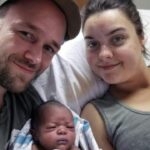A mother who was criticized for having a “big” baby bump is standing firm against pregnancy stigma.
Eliana Rodriguez, now 29, recently welcomed her second child, Sebastian. Despite having a healthy pregnancy and baby, her larger-than-average bump attracted comments such as “You are gigantic,” “You seem to be expecting twins,” and “Have you checked if there’s another baby in there?” Nevertheless, both Rodriguez and her child remained in excellent health.
While a large bump during pregnancy can sometimes indicate health issues, it can also be perfectly normal as a woman’s body adapts. Rodriguez reassured everyone that she and her baby were in great health.
“I had large pregnancies; both of my children were born weighing 8.3 pounds. My 3-year-old daughter Sofia was 19.5 inches at birth, while my new son was 20.5 inches,” she said.
Rodriguez noted that while it’s easy to ignore online trolls, people can be intrusive in person as well.
She acknowledged the curiosity but maintained her politeness. “Yes, I am huge and it’s hard,” she would respond.
A business entrepreneur in Las Vegas, Nevada, specializing in health and wellness, Rodriguez reflected, “I wondered why my tummy was bigger than other women’s. My doctors explained it was normal because I am only 4’11” and have a shorter torso.”
She started showing early in her pregnancy and embraced the excitement, sharing, “I’m an open person, so I was delighted to share. We had been trying for a second child and hoped for a boy.”
During her pregnancy, Rodriguez carried a lot of amniotic fluid, which fills the amniotic sac, protecting and allowing the fetus to move.
The Mayo Clinic describes “polyhydramnios” as excess amniotic fluid, occurring in 1% to 2% of pregnancies. Most cases are unproblematic, though it can lead to preterm labor.
Rodriguez mentioned that despite her high amniotic fluid levels, her doctors confirmed she did not have polyhydramnios. “They measured the baby’s size and the amount of fluids,” she explained.
Chicago-based OBGYN Dr. Kiarra King (who did not treat Rodriguez) added that excess fluid can also result from maternal diabetes and fetal structural anomalies. However, a large belly isn’t solely due to polyhydramnios. Conditions like fetal macrosomia, maternal obesity, or Diastasis Recti—where abdominal muscles separate after previous pregnancies—can make a pregnant woman appear further along than she is.
Fortunately, Rodriguez avoided all these issues.
Dealing with intrusive questions, Rodriguez stressed the importance of avoiding pregnancy and body-shaming remarks. She warned that body image criticism can push women experiencing prenatal or postpartum depression “into a terrible place.”
“I understand that some individuals have less sympathy for others,” Rodriguez said. “As a religious woman, I feel so bad for people who use cruel words.”
4o
Share via:


